Rubinstein and Red Noses
In 1902, Helena Rubinstein opened her first beauty salon at 138 Elizabeth Street, Melbourne. By 1905, she had money in the bank and a thriving business. Rather than settle for what she had achieved, Rubinstein went searching for new ideas and made a number of trips through Europe to investigate developments there. Unlike Elizabeth Arden, who made an exploratory trip to Europe in 1915, Rubinstein did not confine herself to the beauty salons of London and Paris. She also investigated new medical treatments, particularly those used by dermatologists.
See also: Helena Rubinstein
While overseas, Rubinstein corresponded with her Australian and New Zealand clients through advertisements in local newspapers. These were often written up like journal entries and included her thoughts on what she saw and hints of new treatments she would introduce on her return.
ON TOUR WITH MADEMOISELLE HELENA RUBINSTEIN
Berlin, 10th October.
I am still spending my days in the capital of Germany, breaking my stay by occasional trips to Vienna. I am satisfied that the Austrians and Germans between them are wresting from France the supremacy in matters of Beauty Culture which she has been enjoying these many years. And with justice. Beauty Culture in France was always purely a matter of cosmetics: Cacher, pas guerir—covering up, not curing. Complexion blemishes in France were covered up, pasted, painted, powdered over. Then came the Americans with their surgical and electrical remedies and devices; after them the Austrians and Germans, who not only overtook them but completely outpaced them, remaining the scientific masters of the situation. Prevention and cure—permanent cure—is their motto. I can give numerous illustrations, but two or three will show what I mean:
Freckles come to plague women in France as elsewhere. The Frenchman gives you a lotion or ointment, which may or may not remove them; at all events you will get a liquid-powder to cover them up. The Teuton, too, has remedies for freckles, but he must also find out how they are caused; and knowing the cause must overcome it. He learns that freckles are caused by certain rays of the sun which on reaching the skin set up a chemical process of discoloration. These are the blue and violet rays. He sets himself to counteract this chemical action by another. He discovers the very substance which when rubbed into the skin scouts the power of the sun’s rays, protects the skin and keeps it beyond harm’s reach. This article, for which I have secured the sole Australasian rights, is now on its way to Australia, and New Zealand. So much for prevention!
Now for cure: Take the frequent cases of red noses. Again, the Frenchmen will cover up—perhaps will give you an ointment with which he will attempt to bleach away the redness, but which will not act on the cause or seat of the trouble. The Teuton on the other hand knows that the affliction is caused by widened blood-vessels in the skin, which he destroys painlessly with an electric needle—and the red nose is “a has been”!
And so down the line. Whatever is done is done with a view to permanency. Pale cheeks, for instance. In France—rouge, of course. The Teuton women do not like pale cheeks either. But fanatically enough, she would much rather not use rouge, if she can help it. At the expense of being confined to her room for a few days she can and does help it—by having rosebloom tatooed into her cheeks, there to remain permanently. Thus you can’t accuse her of painting. See?(Helena Rubinstein advertisement, Evening Post, 1907)
Lassar’s red nose treatment
The red nose treatment Rubinstein mentions refers to a medical treatment for rosacea or rhinophyma developed by Professor Oskar Lassar [1849-1907], a dermatologist based in Berlin. First used in the 1890s, it was was widely reported in the press in 1906 after his treatment was covered by the journal ‘American Inventor’.
A Cure for Red Noses
The permanent redness of a nose is due to pathologically enlarged blood vessels, and can be produced by different causes. It may be said, however, that excessive drinking is far more seldom the cause of this anomaly than is generally supposed; in fact, the redness is most commonly produced by an extensive though very slight freezing, resulting in a morbid sensitiveness of the blood vessels as to variations in temperature.
An efficient means of remedying abnormal redness consists in scarifying by scratching the extremities on the small veins concerned. This process is, however, rather lengthy, and, moreover, is liable to result in an even more serious disfiguring of more than the original anomaly. Now Professor Lassar, of Berlin, has designed a very suitable apparatus for treating red noses.
An electrometer is made to drive a concussor (as used e.g. in filling teeth). The latter is provided with a stamp working in vertical direction, and to the centrifugal end of which a bundle of about 40 thin gilded platinum points has been attached. This stamp can be inserted and removed by means of a convenient key, and is disinfected carefully before each treatment. The nose can be anaesthetised by chlorethyl spray, though most patients readily endure the prickling treatment. This is made by producing a very full bleeding of the skin (cleaned carefully beforehand) by the vertical application of the needles kept on for some minutes. The bleeding is arrested instantaneously by compression.
Six to eight sittings (one to two per week) are said to be sufficient in most cases to restore even the most abnormal nose permanently to its normal colour without leaving and scar by the superficial destruction of the excessing blood vessels.
The rapidly repeated prickling may be combined with the use of galvanocaustical or electrolytical needles. Dermatologists have been using the device with a marked degree of success, and it may serve the purpose of eliminating birth-marks and other blemishes of the skin.—Berlin correspondent of American Inventor.(Otago Witness, 1906)
Rubinstein and the Lassar Treatment
Rubinstein first used Lassar’s red nose treatment in Australia in 1905. The procedure was also available in her London salon after it opened in 1908 and a photograph of the treatment being carried out in the London salon appeared in her brochure ‘Beauty in the making’.
Of all the disfigurements that may befall womanhood, the development of a red nose is the most dreadful.
The reason for this fear lies not only in the fact of extreme unsightliness, but also in the possible inferences of intemperance which the popular mind is apt to draw from the presence of this disorder. Often enough the conjecture is well founded, and then a red nose meets with scant sympathy. But more frequently the suspicion lacks foundation, and then the veiled illusion becomes bitter indeed.
Known by the name of Rosacea, or in the French Couperose, this affliction, which is caused by disturbance of circulation, consists of inflammation of the skin. It is, unfortunately, commoner in woman than in man. It assumes varied forms, but in its severest form it occurs more frequently in man. Thus nature balances her accounts.
The origin of the disfigurement is not always due to exposure to cold winds and strong sun any more than it can be ascribed to dietary indiscretions alone. Very often the wearing of a veil which adheres closely to the nose give rise to a local irritation which proves the initial cause of trouble.
In its mildest manifestation it shows a slight redness of the lower part of the nose and about the adjacent part of the cheeks. This colour varies in intensity from pink to dull red. This is the first stage of the complaint.
The second is developed when, as a result of these outbreaks of flushing, the small blood-vessels beneath the skin’s surface congest and dilate, appearing like so many red, wavy, vein-like lines. They are generally first seen crossing the folds which run from the sides of the nose towards the corners of the month. They occur also on the nose, itself, and on the cheeks.
In the third stage this network of congested blood-vessels becomes closer and spreads to the centre of the cheeks, taking possession also of the forehead and chin. The colour becomes an intense red, often deepening to a purple. The dilated blood vessels become thicker and more abundant, and finally present a mottled appearance.
The affliction, in its first form, yields readily to soothing and astringent remedies. In its further progress soothing and astringent remedies are still advised to allay the inflammation, but the dilated veins require special treatment by destruction.
The increased fibrous tissue in the severer stage will yield most readily to the treatment devised by Prof. Lassar.
Sufferers from this disorder should observe a strict diet. Everything must be avoided which experience has shown to cause and flushing of the face. It may be that curries are even more harmful than alcohol.(Beauty in the making, c.1908)
The Lassar device is being used on the cheeks, where surface veins can also appear, rather than on the nose as would be the case with rhinophyma. As well as providing the Lassar treatment Rubinstein also sold an ointment and powder for individuals with milder conditions.
Novena Red Nose Ointment
[F]or use at night, and accompanying Powder for day use, will be found very successful in reducing redness in the early stages of the trouble.(Beauty in the making, c.1908)
Medical or cosmetic
Rubinstein was not the first beauty culturist to take a medical treatment and use it in a beauty regime. Electrolysis, for example – which began as a medical treatment for aberrant eyelashes in the 1870s – was in use in many beauty salons by the 1890s to treat superfluous facial hair.
See also: Electrolysis
To our modern eyes the Lassar treatment seems medical and out of place in a beauty salon but there was little regulation in place at the time and the line between medical and cosmetic was often crossed. This was particularly true of electrical devices which were often found in salons and surgeries. As the twentieth century progressed, the medical profession became increasingly critical of the beauty industry and medical organisations pressured governments to close down some long-standing beauty practices.
See also: Face Skinning
Collagen Induction Therapy
Today, laser treatments aim for the same results as Lassar’s red nose device. However, puncturing the skin with small needles is again being practiced, although for a different reason to those already outlined.
Also known as Skin Needling or Dermal Mesotherapy, Collagen Induction Therapy (CIT) has been used in treatments to improve skin texture, smooth wrinkles, reduce the visible signs of scars and stretch marks, and reduce the appearance of hyper-pigmentation, sun spots and enlarged pores.
In CIT, the skin is punctured with tiny needles using a hand-held needle roller or a similar electrical device. The principle behind the procedure is that the needles cause micro-trauma to the dermal layer of the skin, which then initiates the body’s wound healing processes. Like Lassar’s red nose treatment, clients are given a topical anaesthetic before the procedure and there would be visible signs of trauma afterwards, namely blood and swelling, that would require care but quickly fade.
As the individual skin traumas produced by the needles are minute, there should be no visible sign of damage from the procedure after the skin heals. In addition, the risk of visible pigmentation changes is kept to a minimum. Collectively, the small individual wounds can add up to produce a positive change in the appearance of the skin. In particular, it is claimed that as the wounds induce the production of collagen; skin is firmed.
It might be thought that CIT devices would only be available to dermatologists and cosmetic surgeons but they are widely used in beauty salons and can also be purchased by individuals for use at home. It seems rather risky to allow open access to what is essentially a minor surgical procedure. However, given that individuals are buying up old electrolysis machines for home use, this may be part of the increasing trend for self-medication, using materials purchased via the Internet. If Helena Rubinstein had been aware of the possibilities of using skin needling in this way, she would probably have been one of the first to employ it.
Updated: 19th November 2017
Sources
The McIntosh Battery & Optical Co. (1903). The Skin. Its care and treatment according to the Michaud system. Chicago, Ill: Author.
On tour with mademoiselle Helena Rubinstein. Evening Post, December 7, 1907.
Rubinstein, H. (n.d.) Beauty in the making: The stepping stones thereto. Sydney.
Science and invention: A cure for red noses. The Watertown Re-union, April 4, 1906.
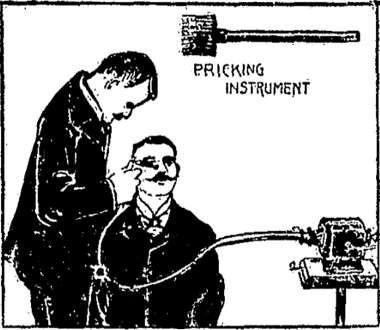
1906 Image from a newspaper article describing Lassar’s red nose treatment (The Watertown Re-union, 1906).
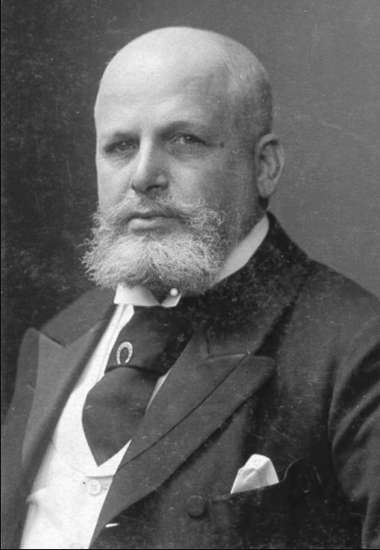
Professor Oskar Lassar [1849-1907]
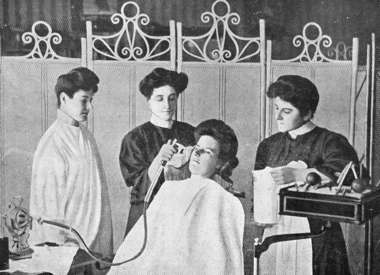
c.1910 Helena Rubinstein in her London salon overseeing a treatment using Lassar’s equipment for treating rosacea and rhinophyma. Rubinstein stands on the left looking very much like a doctor/scientist overseeing an operation – a favourite stance for her – while attendants, dressed in costumes very similar to nursing uniforms of the time, conduct the treatment.

Detail of a red nose treatment above. The head on the device is quite large.
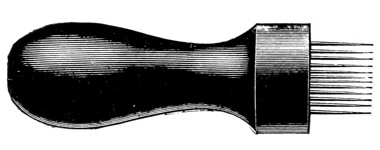
1903 McIntosh Battery & Optical Company Needle Disc. Helena Rubinstein was not the only one to use the technique of puncturing the superficial blood vessels in skin blemishes. In the United States the McIntosh Battery & Optical Company of Chicago had a similar electrical device that used a needle disc to remove nevus flammeus commonly called ‘port wine stains’. In a book published for use by beauty culturists they describe how it was to be used. “In the work of removing naevi, or wine marks, one of two methods may be employed. If the discoloration is small, the platinum needle may be used, attached, of course to the negative pole. This needle should he inserted first in the center of the growth, and then at least five punctures should be made in the tiny capillaries which radiate from this source. Should the growth be larger, the second method may be employed. This calls for the use of the needle disc, and in this method the entire area is treated by a single application of the numerous points. In some instances, much blood escapes from the tiny apertures. This generally lasts but for a few moments, and is of no consequence. If, however, it seems desirable to alleviate this condition, the application of the positive electrode by means of a platinum needle will almost instantly produce the desired result.” (McIntosh, 1903, pp. 133-134)
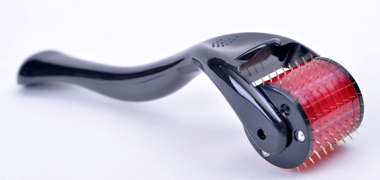
An example of a dermal roller used in Collagen Induction Therapy.
